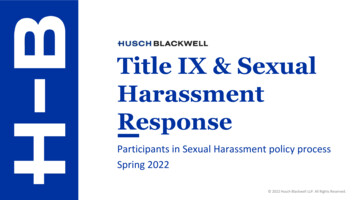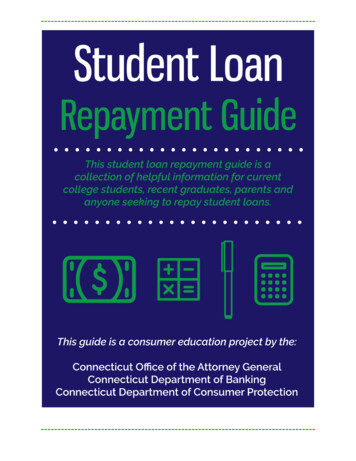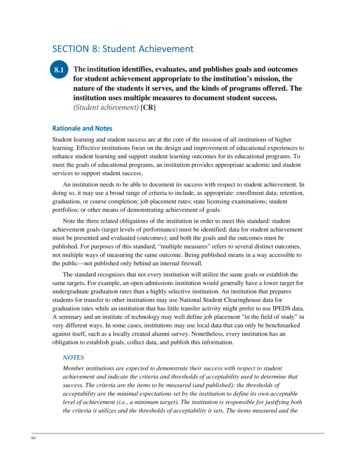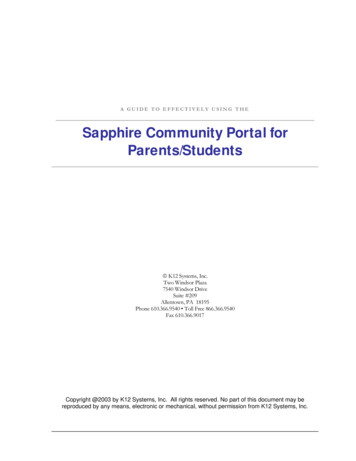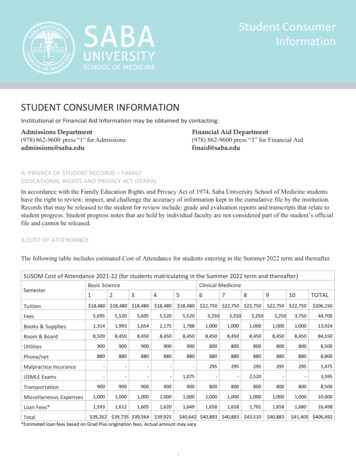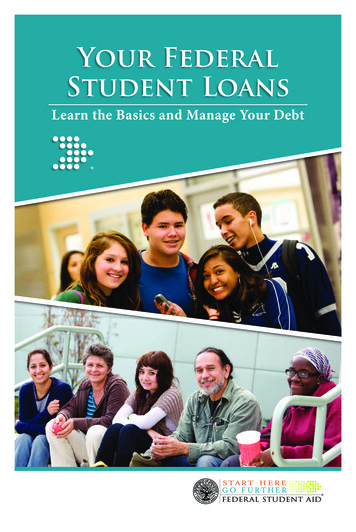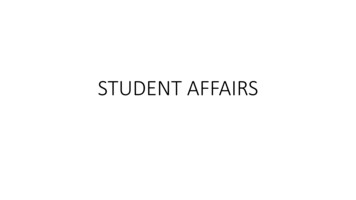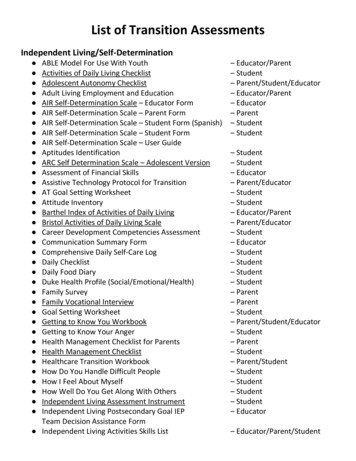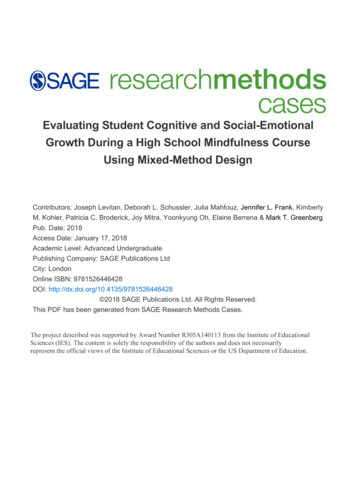
Transcription
Evaluating Student Cognitive and Social-EmotionalGrowth During a High School Mindfulness CourseUsing Mixed-Method DesignContributors: Joseph Levitan, Deborah L. Schussler, Julia Mahfouz, Jennifer L. Frank, KimberlyM. Kohler, Patricia C. Broderick, Joy Mitra, Yoonkyung Oh, Elaine Berrena & Mark T. GreenbergPub. Date: 2018Access Date: January 17, 2018Academic Level: Advanced UndergraduatePublishing Company: SAGE Publications LtdCity: LondonOnline ISBN: 9781526446428DOI: http://dx.doi.org/10.4135/9781526446428 2018 SAGE Publications Ltd. All Rights Reserved.This PDF has been generated from SAGE Research Methods Cases.The project described was supported by Award Number R305A140113 from the Institute of EducationalSciences (IES). The content is solely the responsibility of the authors and does not necessarilyrepresent the official views of the Institute of Educational Sciences or the US Department of Education.
SAGESAGE Research Methods Cases Part 2 2018 SAGE Publications, Ltd. All Rights Reserved.AbstractBetween 2014 and 2017, an interdisciplinary group of researchers examined whether a highschool health class that incorporated mindfulness techniques lowered students’ stress andimproved their wellbeing. We received a grant from the Institute of Educational Sciences from theUnited States Department of Education to (1) train high school health teachers to implement themindfulness-based curriculum and (2) study how the program impacted students. We examinedchanges in cognitive, social, emotional, and physical wellbeing indicators from before the courseto after the course, using a quasi-experimental (intervention and control group with pre and posttests), mixed-methods (concurrent triangulation) design. Data consisted of student responses topsychometric surveys and interviews with a subsample of students. When we comparedqualitative findings with quantitative outcomes, we discovered instances of different resultsthrough each method. This allowed us to provide explanations and context for certain outcomes.For example, the recent loss of a grandparent explained why one student scored high in socialisolation. At other times, the two methods found two different “outcomes stories” from the samestudent. For example, a student reported in the interview that he was struggling with socialinteractions, but the psychometric indicators had him in the top quintile of social wellbeingindicators as compared to his peers. This case study discusses methodological approaches tomixed-method educational psychology research, the challenges of making sense of data fromdifferent sources, and the usefulness and limitations of mixed-methodologies for psychologicaloutcome evaluations of student wellbeing interventions. We also discuss the process of workingas a large group of researchers. This case is useful for students in psychology and education,and it is equally useful for early career researchers.Learning OutcomesBy the end of this case, students should be able toState advantages and drawbacks of different mixed-methods approaches for psychologicaland educational researchIdentify methodological approaches that lend themselves to particular kinds of researchfindingsEvaluate how to make sense of divergent findings from different methods in mixed-methodstudiesProject Overview and ContextThe research took place between 2014 and 2017. Data collection and the first stage of analysishave been completed. The preliminary results have been presented at national and internationalPage 2 of 19Evaluating Student Cognitive and Social-Emotional Growth During aHigh School Mindfulness Course Using Mixed-Method Design
SAGESAGE Research Methods Cases Part 2 2018 SAGE Publications, Ltd. All Rights Reserved.conferences, and research papers are in preparation. The research team consisted ofestablished scholars in psychology and education, early- and mid-career researcher associates,and advanced doctoral students. The team was organized into two main sub-groups, qualitativeand quantitative, with the principal investigator coordinating with each. The work process isdiscussed in more depth below.The research was designed to study the impact of an educational intervention. Health teacherswere trained to present a 12-lesson mindfulness-based wellbeing program (12, 45-min lessons)called Learning to BREATHE or L2B. The L2B curriculum focuses on cultivating students’awareness of their thoughts, feelings, and physical sensations to improve their development ofemotion regulation and attentional skills.We performed this research in an Eastern state in the United States at two public, suburban highschools outside of a midsized city. Overall, 385 adolescents aged 15 to 17 participated inanswering a battery of surveys and playing cognitive “games” to measure their emotional, social,and physical wellbeing as well as changes in cognitive functions. A subsample of the studentswas also interviewed to gain a deeper understanding of their experience, certain aspects of theL2B curriculum, and self-defined changes from the students’ perspectives. The studentpopulation at both schools was ethnically diverse. School A had 23% students of color fromvarious backgrounds (Latino, Black, Asian, first and second generation immigrants), while SchoolB consisted of 62% students of color. They were also socio-economically diverse (14% ofstudents on free/reduced lunch at School A, and 47% at School B), and had a range of academicaptitudes.The research design was mixed-method and quasi-experimental, meaning that we collected bothqualitative (interview) data and quantitative (survey and cognitive “game”) data, and that westudied the intervention (the L2B course) in comparison to a control group who did not didreceive the L2B course during the study (Creswell, 2013; Creswell & Clark, 2007; Creswell, Clark,Gutmann & Hanson, 2003; Maxwell & Loomis, 2003). In each school, one group of students (n 132) participated in the L2B curriculum, and a control group (n 119) participated in the standarddistrict health course curriculum for a total of 251 participants in the randomized controlled trial(134 student participated in the pilot study). Students in both groups at both schools were testedbefore the intervention and after the intervention to compare scores and measure changebetween pre-course scores and post-course scores. The students were also interviewed after theintervention to reflect upon what they learned and how the program impacted them.Gaining access to these schools and administering the surveys posed some challenges, but thegreatest challenges involved interviewing the students, which will be discussed in-depth below.Page 3 of 19Evaluating Student Cognitive and Social-Emotional Growth During aHigh School Mindfulness Course Using Mixed-Method Design
SAGESAGE Research Methods Cases Part 2 2018 SAGE Publications, Ltd. All Rights Reserved.The research questions for this aspect of the project were as follows:1.How do high school students experience and manage stress in their lives?2.What are the effects, if any, of a mindfulness curriculum on students’ wellbeing?Research has shown that high school aged students face significant stress relative to otherstages of development (Tottenham & Galvan, 2016), which has been attributed to increases inschool dropout (Kessler, Foster, Saunders, & Stang, 1995), as well as negative effects onstudent’s grades, healthy decision-making, cognitive functioning, and overall wellbeing (Gumora& Arsenio, 2002; Sapolsky, 2003; Vermeersch, T’Sjoen, Kaufman, Vincke, & Bracke, 2010). Withthe concerning rates of depression and school drop out, educational psychologists and policymakers have begun to pay greater attention to how schools can teach students approaches tolower their stress and cultivate student wellbeing to foster healthy attitudes and behaviors. Oneapproach to fostering student wellbeing is through health courses that integrate mindfulnesstechniques to allow students to de-stress while in class and to learn about effects of stress onwellbeing and decision-making (Broderick & Jennings, 2012). Research on mindfulness foradults has shown positive outcomes for stress reduction and wellbeing (Chiesa & Serretti, 2009;Frank, Reibel, Broderick, Cantrell, & Metz, 2013), which is why this research project set out tounderstand the effects of mindfulness practices on adolescents, and the possibility ofincorporating the techniques in school.This study is unique in using a quasi-experimental and mixed-methods research design toexamine a mindfulness-based intervention facilitated by a classroom teacher in a universal healthclass. In fact, most research projects on mindfulness and psychological wellbeing rely onquantitative, self-report measures, even though scholars have found limitations to this approach,such as work from Davidson and Kasniack (2015). Heeding this call, our research employed aspecific mixed-methodology to better triangulate findings and draw a more detailed picture of theeffect of the interventions on students.Research PracticalitiesThe research was made possible thanks to a large multi-year grant from the Institute ofEducational Sciences (U.S. Dept. of Education). Mark Greenberg and Jennifer (Jenny) Frankfrom Penn State University were the co-principal investigators (PIs), while a team of quantitativeand qualitative researchers performed particular data collection and data analysis tasks. Thequalitative team consisted of Deborah Schussler, Julia Mahfouz, and Joseph Levitan, and thequantitative team consisted of Joy Mitra, Yoonkyung Oh, and Kimberly Kohler. Elaine Berrenaand Patricia (Trish) Broderick focused on teacher training for implementation of the curriculum,and also developed evaluation protocols for implementation fidelity. Trish Broderick (2013) is alsoPage 4 of 19Evaluating Student Cognitive and Social-Emotional Growth During aHigh School Mindfulness Course Using Mixed-Method Design
SAGESAGE Research Methods Cases Part 2 2018 SAGE Publications, Ltd. All Rights Reserved.the author of the L2B curriculum. Each team was fairly autonomous in their respective tasks. Thisrather large interdisciplinary team spanned the Departments of Educational Psychology, HumanDevelopment and Family Studies, Education Leadership, and Special Education.The large size of the full research team allowed for in-depth data collection from both qualitativeand quantitative methodologies but also made communication and setting meeting times achallenge. Each smaller team met separately on a regular basis, and the full team would meetbi-weekly, on average, depending upon the phase of the research project. The large size of thefull research team provided depth and expertise for each phase of the research, which was aconsiderable strength. Despite this strength, there were a number of challenges to overcome inorder to complete the research, which we discuss below.Sampling, Teacher Recruitment, and Access to SchoolsEstablishing a relationship with schools willing to partner and work to achieve the fundamentalgoals of the program, and participate fully in the research, is a necessity for any successfulproject. Regular visits to the schools were required for a variety of reasons. First, it wasnecessary to solidify the administration’s commitment to the project and the changes in thehealth curriculum, which involved the superintendent and both high school principals. Second, itwas necessary to train and support the participating health teachers to implement the curriculum,which included several trainings that supported the teachers’ own mindfulness practices andvideotaping all lessons across teachers’ classes during all phases of the project to ensure qualityinstruction and fidelity to the program. Trainings were provided both in preparation forimplementation and to promote sustainability of the mindfulness curriculum in the schoolcurriculum. Third, a team visited to administer the quantitative student self-report measures andcognitive tasks both prior to the students’ participation in the L2B lessons and after they finishedthe program. Fourth, the qualitative team had to recruit and arrange student interviews. Finally,occasional check-ins with the administrators and weekly coaching calls with the participatingteachers were important to maintain the integrity of the relationship. Given the intensity of timerequired in the schools, it was important to have sites that were within a reasonable distance fromthe university.The selection of the sites occurred through pre-existing contacts between both Trish and Mark.As the creator of the curriculum, Trish provides trainings nationally and internationally on how tofacilitate the L2B curriculum. Around the time the grant was being proposed, Trish solicitedapplications to participate in a scholarship-supported training of L2B. All applicants were requiredto have a letter from their principal stating that the participant would actually teach L2B in theschool, in some form, if they attended. The announcement was circulated through a mindfulnesslistserve. One of the teachers who attended Trish’s training was very interested in offering thePage 5 of 19Evaluating Student Cognitive and Social-Emotional Growth During aHigh School Mindfulness Course Using Mixed-Method Design
SAGESAGE Research Methods Cases Part 2 2018 SAGE Publications, Ltd. All Rights Reserved.L2B curriculum in her health classes. Mark also had been in contact with the district where theschools were ultimately selected for other research projects, so there was a positive priorrelationship. Given the diversity of the district, the interest of a teacher who had received sometraining, and a positive relationship with the administration, the district was a good fit.The trained teacher encouraged another teacher at the other district high school to participate.Trish also presented a short program to the district’s health department to gauge additionalinterest. Although it seemed more teachers were interested in getting involved, the time requiredfor teacher training and then the abbreviated time for their regular health curriculum whenimplementing the L2B lessons seemed to deter other teachers from participating in implementingthe L2B curriculum. However, we were able to recruit other teachers at both schools to participatein the research by being a part of the “business as usual” control group. This involved allowingthe team to collect pre- and post- quantitative self-report measures and cognitive tasks aroundthe same time as the intervention teachers.Clearly, it is important to select research sites that meet the goals of the research. We were veryfortunate because the two schools where we conducted the research not only fell within thesame district, but also had some interesting demographic differences. One of the schools wasmore affluent and less racially/ethnically diverse, while the other was more diverse and lessaffluent. This allowed us to examine different cultural and contextual influences.It is also crucial to work with flexible and collaborative partners. Fortunately, the teachers werevery helpful in navigating practical issues and tensions of school research. For example, theyhelped the team figure out how to combine the realities of course schedules with ideal quasiexperimental design. In fact, the collegial relationships that developed between teachers andresearch team members strengthened the research process. For the qualitative team, theteachers were extremely helpful for gaining insight into the subtlety of the implementation andtheir classroom dynamics, and providing the contextual descriptions that are so important toqualitative research.Ethical ClearanceReceiving approval from the university ethics board—and maintaining that approval when makingchanges and updates to the protocol—was a time intensive process. Joy Mitra worked closelywith the Institutional Review Board of Penn State, whose representatives were very helpful, butalso rigorous and stringent on ensuring that the research process conformed to the strict ethicalstandards of the university and the protection of minors.The IRB staff members were particularly concerned about ensuring that the privacy of thePage 6 of 19Evaluating Student Cognitive and Social-Emotional Growth During aHigh School Mindfulness Course Using Mixed-Method Design
SAGESAGE Research Methods Cases Part 2 2018 SAGE Publications, Ltd. All Rights Reserved.students was protected. Also, as the students were all minors, special protections are in place toensure that students were not coerced into participating in the research. This includes the kind ofincentives students can receive for participating in the research. For example, the IRB staff didnot want to have minors receive cash payments as an incentive. Instead, small items, like waterbottles, gift cards, or backpacks were deemed acceptable incentives.The primary lesson from Joy’s IRB work is that establishing a collaborative relationship with theindividual responsible for ethical clearance is extremely useful as she or he can have useful timesaving tips. Also, for research that requires certain changes throughout the research process(which most multi-year research does, in our experience) the IRB staff member can facilitatethose changes and provide advice about when those changes require a formal modification andwhen they do not.Each data collection approach needed to be approved by the IRB board, from the surveyinstruments, to the cognitive “games,” to the interview protocols. Since the students were under18 years old, the collection instruments also required consent from parents, which was a difficultchallenge, considering that this required getting the consent letter home to all the parents of thestudents involved in the L2B program and the students in the control group who were taking thesurveys. The IRB and school district approved a protocol where parents responded with “passiveconsent,” which was very helpful. Passive consent means parents return the form if they do notwant their child to participate in the research. If we did not receive a reply from parents, thenstudents were able to participate. In addition, students provided their assent to participate on thefirst page of the online surveys students completed during their health class. The subsample ofstudents who were interviewed had to provide additional consent. Their parents had to provideactive consent, which involved returning a consent form stating their agreement that their childcould participate in the interview, and the students had to provide their consent. Because it wasdifficult to achieve active consent to complete the interviews, we offered gift cards as incentivesfor participating.Research DesignWe used a quasi-experimental, (intervention and control group with pre and post tests), mixedmethods (concurrent triangulation) design to study the effects of the intervention (Creswell, 2013;Creswell & Clark, 2007; Creswell, et al., 2003; Maxwell & Loomis, 2003). The research consistedof three phases. In Phase 1, the team worked with one teacher to implement the L2B curriculumand test out the lessons, the video recording process, and the coaching protocol. Phase 2 wasthe pilot research, where we implemented all of the data collection instruments on multiple L2Bclasses, with two teachers, but we did not collect data from control classrooms. We thenamended certain data collection practices to ensure reliable implementation in Phase 3: thePage 7 of 19Evaluating Student Cognitive and Social-Emotional Growth During aHigh School Mindfulness Course Using Mixed-Method Design
SAGESAGE Research Methods Cases Part 2 2018 SAGE Publications, Ltd. All Rights Reserved.controlled trial.In the Phase 3 controlled trial, the teachers implemented the L2B lessons in their health classeswhile other health teachers at each school taught the standard district-wide health curriculum.The students of all classes took the refined battery of surveys and cognitive “games” about 2.5months apart, so that measurement occurred before the intervention group began the L2Bprogram and after they finished (see Web Resources below, for a sample list of publishedsurveys used for this project). During Phase 2, students in the intervention group wereinterviewed after participating in L2B, while in Phase 3 students in the intervention group wereinterviewed both before and after participating in L2B. In the mixed-methods research, we usedata from both Phase 2 and Phase 3.Although the design is fairly straightforward we had a number of difficulties in getting all studentsto take the surveys seriously. Joy reported that some of the students would simply click throughthe questions too quickly to have been reading the survey items, and there was an incidentwhere a few students got up and caused some ruckus in the classroom while the students werefilling out the surveys. The researchers could not help this, but we did take note of the possibilityof erroneous data.In part, the issue of student attention occurred because we underestimated the timecommitments—and accompanying frustrations—of filling out surveys. Students and teachersface constant interruptions of instructional time by State-mandated tests, Advanced Placementexams, College Boards, and so on. The teachers are always working upstream to stick tocurriculum, and the students sometimes feel overwhelmed by the amount of time they spendanswering multiple-choice questions on the standardized tests that they are required to take.Given this context in the classroom, our 2-day data collection activities (which for controlled trialclasses occupied six full classes of instructional time) sometimes led to frustration and resistanceon the part of students (and even sometimes for the teachers, too). This is an important lessonlearned in the data collection phase for school-based research. Schools are very busy places,more so now than ever, and researchers need to have high sensitivity to teachers’ and students’time. Knowledge about time constraints is best understood through discussion with teachers andwith students.The qualitative team also had to recruit a subsample of students to volunteer for the interviews.We decided that we would go to the schools and offer students some incentive to come talk to usabout the research project and to ask if they would be willing to volunteer. We started thisprocess by asking the teacher to tell the students in the L2B health course that we would havepizza and soda for them to learn about the qualitative aspect of the research project. Once we allhad pizza, we asked the students if they wanted to volunteer to be interviewed. We did this onPage 8 of 19Evaluating Student Cognitive and Social-Emotional Growth During aHigh School Mindfulness Course Using Mixed-Method Design
SAGESAGE Research Methods Cases Part 2 2018 SAGE Publications, Ltd. All Rights Reserved.two separate occasions. We arrived at the school a bit before the students’ series of lunch breaksin order to set up the pizza and sodas. We had a number of students come in during eachperiod.Convincing adolescents to do something that may be outside of their immediate interests is neveran easy endeavor. Fortunately, each person on the qualitative research team had been a K-12teacher, and one had been a principal, so we put on our “teacher hats” to explain to the kids whowe were, what we were doing, and why we needed their help. We also told the students that ifthey completed the interviews, they would receive a US 15 gift card. We told the students thatthey needed to have their parents sign a consent form, and then we would text them about atime to meet either at the school or by phone. We were careful not to be coercive in any way, andfollow the proper IRB guidelines.Some students were more interested than others. We had over 30 students say that they werewilling to participate in interviews, but only 19 students ended up getting the paper work signedand completing the interviews. This was a little disappointing to the qualitative team as it limitedthe diversity of students from whom we were hoping to collect qualitative data. However, we werestill able to complete our research objectives.Getting adolescents to volunteer to do anything, even with the promise of some kind of reward, isa difficult aspect of school-based research. Although we were all teachers and knew the agegroup, there are characteristics of the teenage stage of development that just cannot becontrolled for—mostly that they are wrapped up in their own lives. Without a significantinvestment or a major incentive (we offered a minor incentive), many teenagers are unlikely tofollow-through on their tertiary, extra curricular commitments, and those who do, often needconstant reminders.Recruiting volunteers for this study had a significant methodological drawback. We were unableto achieve maximum variation sampling (Patton, 2005), which would have provided a morecomprehensive set of findings for the qualitative aspects of the research. The students who werewilling to be interviewed were generally responsible, moderately to high achieving teenagers.Nonetheless, we did achieve some diversity in the sample. Furthermore, the qualitative dataallowed us to triangulate the quantitative findings and add complexity and nuance to theoutcomes report of the intervention. Before we discuss those outcomes, however, we need to goa little more in depth on the data collection.Data Collection DesignWe collected quantitative data and qualitative data concurrently to triangulate the findingsPage 9 of 19Evaluating Student Cognitive and Social-Emotional Growth During aHigh School Mindfulness Course Using Mixed-Method Design
SAGESAGE Research Methods Cases Part 2 2018 SAGE Publications, Ltd. All Rights Reserved.(Creswell, et al., 2003). This means that we collected the quantitative data in a separate processfrom qualitative data even though both sets of data were collected during the same time period.To perform this task, the quantitative team developed their protocols separately, though with inputby the qualitative team, and the qualitative team developed their protocols separately, but withinput from the quantitative team as well.An expert in their particular methodology led each team. It was an interesting experience to delveinto the different epistemologies, or approaches to knowledge and gathering data, that eachmethod asserted when creating each protocol. It was tricky to reconcile these differentapproaches because the quantitative team approached their survey selection and creationthrough finding carefully worded, direct questions that measured the outcomes of interest andtested their hypotheses. So, the items were tested for validity and reliability. This means that thequantitative team made sure that the questions were validly measuring the right ideas (that thestress survey was actually measuring stress) and that they were reliable (meaning that the stresssurvey was accurately measuring the amount of stress) (Fink & Litwin, 1995). This approach insome ways runs contrary to the inductive approach that the qualitative team wished to employ forthe student interviews. We sought to understand how the students made sense of andexperienced the L2B course, in their own conceptualizations, and any changes they may havenoticed within themselves because of the course. The qualitative team spent considerable timecreating the open-ended, constructively neutral questions to allow students to find the words thatmade sense to them in order to understand their experience from their perspectives as much aspossible, while still focusing on the topic of the mindfulness course.When the qualitative team showed the interview protocol to the quantitative team for feedbackthere was some confusion about the approach, and why the questions were so broad. Weexplained that one of the benefits of qualitative interviews is the opportunity to delve deeply intothe contextual, experiential knowledge from the students’ perspectives, in their own words. Wewanted to know what they found important and useful instead of imposing certain ideas on them.In addition, our experience as qualitative researchers has helped us realize that when individualsare asked directly how something has impacted them, they frequently either do not know or theyoffer responses lacking in clarity. However, when those same individuals are asked to describe asituation or tell a story, their responses provide rich reflections about the same phenomenon.Because we wanted to conduct a truly mixed-methods study we also wanted to develop somequestions that might correspond across methodologies. As a result, at the end of the interviewwe incorporated some more direct questions about the programming and certain constructs inorder to make sure all topics were covered directly.Another aspect of data collection design is to develop analytical approaches to understand thePage 10 of 19Evaluating Student Cognitive and Social-Emotional Growth During aHigh School Mindfulness Course Using Mixed-Method Design
SAGESAGE Research Methods Cases Part 2 2018 SAGE Publications, Ltd. All Rights Reserved.data collected. For the quantitative team, their deductive approach to data gathering ensured thatthe analytical approaches, such as analysis of variance (ANOVA) and Latent Class Modeling,were already part of the data collection design. For the qualitative team, we needed to develop acodebook that would allow us to code the data and find themes within the data relevant to ourinvestigation. In qualitative research, developing code-schemes can happen both a priori (beforethe data is collected) and a posteriori (after data are collected). We decided on a hybridapproach where we developed codes for specific themes that we wanted to understand. Forexample, we used some of the quantitative indicators, such as mindfulness and s
lower their stress and cultivate student wellbeing to foster healthy attitudes and behaviors. One approach to fostering student wellbeing is through health courses that integrate mindfulness techniques to allow students to de-stress while in class and to learn about effects of stress on wellbeing and decision-making (Broderick & Jennings, 2012).

